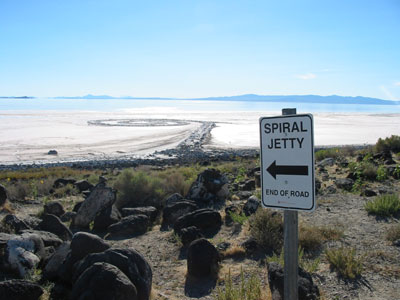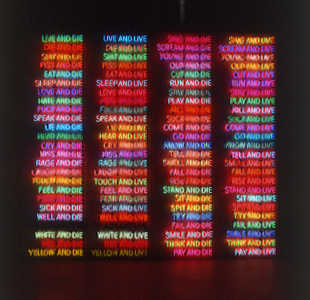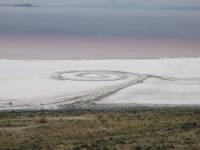So how did there come to be street signs for the Spiral Jetty?
For years, the only way to see Robert Smithson’s Spiral Jetty was from the air, or in a photograph, or in the artist’s own making-of film, which was plenty for 99.9% of art worlders and normals alike.
When the Jetty first re-emerged from the Great Salt Lake in 1994, only a few people knew about it, and even fewer actually took the trouble to drive out and see it. But appetites were whetted, and conceptual art was intersecting with an Easy Rider-meets-Wild, Wild West road trip in just the right slightly adventurous, hip enough way that when it resurfaced again in 2002, visiting the Jetty quickly went from curator-esoteric to art-world-must-see to mainstream.
Artforum’s Number One Top Ten
Whoa. Choire Sicha has gone all Kit Carruthers on Artforum’s monthly Top Ten list; it’s truly a site to behold. Usually, even the brainiest people have a hard time coming up with ten relevant things to say, and they pack it with esoteric crap or their friend’s website or something.
Choire doesn’t–um, actually, he does. There’s esoteric crap (“Remember that awesome Amy Globus video shown last winter at Gorney Bravin + Lee, with two octopuses sucking their way through some weird see-through aquarium tubing while Emmylou Harris and Neil Young sang ‘Wrecking Ball’?”) and his friend’s website (Paul Ford’s Ftrain). Just this time, it’s good.
2004-09-06 , This Week in The New Yorker
![]()
Issue of 2004-09-06
Posted 2004-08-30
THE TALK OF THE TOWN
COMMENT/ UNDER FIRE/ Hendrik Hertzberg on Republican attacks.
THE BIG SHOW/ SCOOPS/ Ben McGrath on the tricks of the news cycle.
DEPT. OF IMPERSONATION/ REPORTING FOR DUTY/ Tad Friend meets a copycat Kerry.
ON THE MOUND/ BITTERNESS/ Michael Shapiro on the curveball career of Jae Weong Seo.
THE FINANCIAL PAGE/ COME ONE, COME ALL/ James Surowiecki on how cities sell themselves to conventions.
TASTE TECHNOLOGIES/ Malcolm Gladwell/ The Ketchup Conundrum/Mustard now comes in dozens of varieties. Why has ketchup stayed the same? /[read a draft at Gladwell.com]
THE POLITICAL SCENE/ John Cassidy/ Tax Code/ The President gives hints of a radical agenda.
LETTER FROM SOUTH AFRICA/ Calvin Trillin/ Dissed Fish/ Confessions of a snoek lover.
FICTION/ Yoko Ogawa/ “The Cafeteria in the Evening and a Pool in the Rain”
THE CRITICS
A CRITIC AT LARGE/ Adam Gopnik/ Through a Glass Darkly/ What do we talk about when we talk about wine?
MUSICAL EVENTS/ Alex Ross/ Unauthorized/ The final betrayal of Dmitri Shostakovich.
ON TELEVISION/ Nancy Franklin/ City of Glutes/ An Olympic homecoming.
THE CURRENT CINEMA/ Anthony Lane/ Power Plays/ “Vanity Fair” and “Hero.”
FROM THE ARCHIVE
U.S. JOURNAL: BREAUX BRIDGE, LOUISIANA/ Calvin Trillin/ Eating Crawfish/ Issue of 1972-05-20
U.S. JOURNAL: KENTUCKY/ Calvin Trillin/ Stalking the Barbecued Mutton/ Issue of 1977-02-07
How to get to Spiral Jetty? It’s never been easier.

On the 10-year anniversary of the re-emergence of Spiral Jetty and my first visit, and in keeping with our family tradition of visiting the Jetty whenever we attend a wedding in Salt Lake City, we popped on over Saturday in a rented Camry.
These new signs made finding the Jetty so easy, even Artforum could do it.
Benesse Art Site Naoshima, the Marfa of Japan
While we were in Japan, we made a detour to see the growing collection of contemporary art on Naoshima, a tiny island near Okayama, and within spitting distance of the massive Seto Inland Sea Bridge.
 In explaining Naoshima, I’ve taken to calling it the Marfa of Japan, but that’s only partly accurate. Benesse represents one collector’s–not an artist’s–increasingly significant attempt to create an internationally recognized destination for contemporary art pilgrims and to revitalize/transform a dying town in the process. I think it’s mostly successful, and definitely worth the trip.
In explaining Naoshima, I’ve taken to calling it the Marfa of Japan, but that’s only partly accurate. Benesse represents one collector’s–not an artist’s–increasingly significant attempt to create an internationally recognized destination for contemporary art pilgrims and to revitalize/transform a dying town in the process. I think it’s mostly successful, and definitely worth the trip.
Benesse Art Site is the new umbrella moniker for four separate art projects: the just-opened Chichu Museum; Benesse House, a small museum/hotel; Seaside Park, a campground surrounded by outdoor sculptures; and Art House, permanent artist installations in abandoned 18th century buildings.
When we arrived on Naoshima, we headed first to Benesse House, which was designed by Tadao Ando. The staff was extremely helpful, even though we knew we couldn’t stay overnight (the hotel fills up a year in advance). The building was impressive, with two or three of the sublime moments Ando’s Fort Worth Museum has dozens of.
The work was all over the place; there’s stuff from a collecting phase where money outstripped sense, then from the “let’s open a museum” phase where sense caught up. Exquisite siting was a recurring theme. Hiroshi Sugimoto’s Time Exposed seascape photos, installed in a courtyard overlooking the sea; Yoshihiro Suda’s invisible Weeds, and Bruce Nauman’s neon 100 Live or Die, which, by restrictions on how frequently it would be turned on, was transformed from sculpture to eagerly awaited performance spectacle.
A businessman on the ferry had boasted, “There’s a $6 million Monet up there.” [A Water Lilies diptych, which was probably more than that.] Meanwhile, the locals remain unimpressed by the $10 million early Johns hanging next to the Zen-like Pollock.
I’ve mentioned it before, but I’ll post more on the Art House Project later.
Benesse Art Site Naoshima, the Marfa of Japan
While we were in Japan, we made a detour to see the growing collection of contemporary art on Naoshima, a tiny island near Okayama, and within spitting distance of the massive Seto Inland Sea Bridge.
 In explaining Naoshima, I’ve taken to calling it the Marfa of Japan, but that’s only partly accurate. Benesse represents one collector’s–not an artist’s–increasingly significant attempt to create an internationally recognized destination for contemporary art pilgrims and to revitalize/transform a dying town in the process. I think it’s mostly successful, and definitely worth the trip.
In explaining Naoshima, I’ve taken to calling it the Marfa of Japan, but that’s only partly accurate. Benesse represents one collector’s–not an artist’s–increasingly significant attempt to create an internationally recognized destination for contemporary art pilgrims and to revitalize/transform a dying town in the process. I think it’s mostly successful, and definitely worth the trip.
Benesse Art Site is the new umbrella moniker for four separate art projects: the just-opened Chichu Museum; Benesse House, a small museum/hotel; Seaside Park, a campground surrounded by outdoor sculptures; and Art House, permanent artist installations in abandoned 18th century buildings.
When we arrived on Naoshima, we headed first to Benesse House, which was designed by Tadao Ando. The staff was extremely helpful, even though we knew we couldn’t stay overnight (the hotel fills up a year in advance). The building was impressive, with two or three of the sublime moments Ando’s Fort Worth Museum has dozens of.
The work was all over the place; there’s stuff from a collecting phase where money outstripped sense, then from the “let’s open a museum” phase where sense caught up. Exquisite siting was a recurring theme. Hiroshi Sugimoto’s Time Exposed seascape photos, installed in a courtyard overlooking the sea; Yoshihiro Suda’s invisible Weeds, and Bruce Nauman’s neon 100 Live or Die, which, by restrictions on how frequently it would be turned on, was transformed from sculpture to eagerly awaited performance spectacle.
A businessman on the ferry had boasted, “There’s a $6 million Monet up there.” [A Water Lilies diptych, which was probably more than that.] Meanwhile, the locals remain unimpressed by the $10 million early Johns hanging next to the Zen-like Pollock.
I’ve mentioned it before, but I’ll post more on the Art House Project later.
On the road again
greg and the rest of the .org gang are on a bit of a trip this week, back on Monday. You can stare at the screen all you want, but there are no bloopers, and there’s no silly coda after the Kodak credit fades.
WWJBD?
 Sharon Waxman has a report from the set of Team America: World Police, a $32 million puppet action film being directed by a couple of reluctant, foul-mouthed punks pulled from obscurity by Paramount.
Sharon Waxman has a report from the set of Team America: World Police, a $32 million puppet action film being directed by a couple of reluctant, foul-mouthed punks pulled from obscurity by Paramount.
Somehow the pair of college buddies, named Matt Stone and Trey Parker, got their pitch–a 3-minute clip of The Thunderbirds with new dialogue dubbed over it–to producer Scott Rudin, and Paramount to greenlight it immediately, even though the guys have no previous puppeteering experience.
Now enduring weeks of 14-hour days shooting, “with three weeks of production to go, the filmmakers found themselves in a warp-speed work schedule of shooting all day, editing half the night and rewriting on the weekends. ‘Every shot is problem solving,’ Mr. Parker explained.”
When they’re stumped, the pair follows one article of faith aspiring action filmmakers would do well to remember, WWJBD? What Would Jerry Bruckheimer Do?
I don’t need no stinkin’ Metropolitan Diary
INT – NYC Friday, 7:30AM
A groggy mid-30’s MAN with bedhead and a 4-day growth of beard crawls into the t-shirt, khakis, and flip-flops dropped the previous night along the trail to his bed. Alternate side parking.
INT – CAR
Sitting in his car, he figures, why not go to this Costco he’s heard of, get those Pampers, that baby formula, maybe a rack of ribs. He crosses the 59th st bridge, drops into LIC, and pulls into the Costco parking lot. When the store finally opens (at 10) he enters, and is stopped by an ATTENDANT.
ATTENDANTMembership card, sir?
MANUmm, I guess I need to pick it up.
ATTENDANTTo your right.
The man wanders to the membership desk and shells out more than he would have saved on his baby gear. Guess he’ll be coming back here again.MEMBERSHIP DESK CLERKStep to the end of the desk for your picture.
MANI need a picture? What for?
CLERKIt goes on your membership card.
MANI just– Had I known, I would’ve gotten all dressed up.
CLERKWould it be that much better?
Spiral Jetty: Still Spiral, Not a Jetty
 Todd Gibson‘s posting an extensive first-hand account of his recent visit to the Spiral Jetty, which, because of an ongoing drought, is now completely out of the water.
Todd Gibson‘s posting an extensive first-hand account of his recent visit to the Spiral Jetty, which, because of an ongoing drought, is now completely out of the water.
That’s fast. Some friends went in early July, and it still had water around it, although the Jetty itself was entirely walkable. [via bloggy]
Faithful pilgrims of contemporary art will also appreciate Gibson’s account of his visit to the Lightning Field. He does get around.
Related: Other Spiral Jetty and Smithson posts on greg.org
Post about a show that included the intriguing backstory of the official photographs of Lightning Field.
On Collectors’ Museums, or pot kettle, kettle pot
WP art critic Blake Gopnik is wants calling for DC’s bigwig art collectors–capitalists all, who else can afford a Richter?–to go communist, and open a collective to share their hoard with the contemporary art-starved DC public.
It’ll never happen, but not for the reasons Tyler Green thinks. If Miami’s experience is any indication, hyper-competitive, status-hungry collectors who open exhibition spaces have less than a 1 in 4 chance of not embarassing themselves.
[When I first did the rounds of the big Miami collections five years ago, I realized four people had–independently? in competition with each other?–bought nearly identical Oldenburgs, the original of which is at the National Gallery. In DC. And when I was introduced to one as a ‘fellow collector,’ her first question was, “Do you collect Gursky? Struth?” Which is unbelievably tacky art world shorthand for “Do you have over $10 million? or do you make over $2 million a year?” The only possible answers, by the way, are “Oh, not any more.” or “Who?”]
Basically, I worry that most collectors would be too self-important, possibly too clueless, and almost certainly too thin-skinned to be able to pull something like this off.
If Blake’s determined, though, he should get in touch with the Rubells, whose Rubell Family Collection put the pressure on their Miami peers in the first place, and who bought a hotel in Washington last year.
Observer: Two’s an Undergound Trend
The UK Observer does a trend story on guerilla media, that starts with grafitti and small-house publishing, but is mostly a mashup on underground bands–kids playing gigs on the tube, for example–and indie filmmakers–like Outfoxed‘s Roger Greenwald, and Chris Jones and Genevieve Joliffe, authors of The Guerrilla Film Makers Handbook.
According to the Observer, J&J “managed to cast Harrison Ford’s little-known brother Terence as the male lead in The Runner,” their 1992 sci-fi? thriller? horror? flick. Considering how hard he is to reach these days, I’m sure the Observer means “then-little-known.”
Art Attack [Observer-UK]
Bloghdad.com/Echo_Company
Philadelphia Enquirer photographer David Swanson and reporter Joe Galloway have created a powerful report on the Marines of Echo Company, which has lost more soldiers in the Iraq War than any other unit so far.
Swanson accompanied the Marines, part of the 2nd Battalion, 4th Company, on many of their battles in the western Iraqi city of Ramadi. The report is based on his journal, and interviews with the “families, friends, teachers, girlfriends, and ministers” of the fallen Marines.
Echo Company, a Special Report from the Knight Ridder Washington Bureau
Knight Ridder was “almost alone” in pre-war reporting of official and expert skepticism on WMD [AJR]
“Now They Tell Us,” Michael Massing’s scathing review of pre-war news in the NY Review of Books
Republican “Switch” Ads, by Errol Morris
You’ve gotta see Errol Morris’s commercials for MoveOn PAC, the unaccountable special interest division of MoveOn.org. Morris took the “Switch” concept he used for Apple, and shot ads of Republicans who discuss switching their vote to Kerry. Morris’s straight-on interviewing style and deft editing manage to convey real peoples’ nuanced, complex, and sincere perspectives. The word that sticks with me most: Betrayed.
Of course, MoveOn’s populist, anti-war-energized donors voted to run the ad about WMD lies, which strikes me as the ad they most want to show Republicans rather than the ad that’s most likely to sway Republicans to switch.
Each ad may elicit its own rebuttal–or, at least there are automatic administration retorts of varying degrees of accuracy/effectiveness; I see the William Harrop ad as vulnerable to criticism of “sour grapes,” and the economic thesis of the Brady Van Matre ad doesn’t make sense. But the cumulative effect of so many Republican voices of discontent is quite powerful.
As a registered Republican (Yow, where’d that come from??) my top picks are Rhonda Nix, Kenneth Berg, and Sid Hasan.
Related:
Philip Gourevitch reports from the set: context, insightful comments from Morris, spin from MoveOn’s Wes Boyd, and a bit of “we’re politicians above all” from the Kerry campaign.
“Confessions of A Republican,” Johnson’s powerful 1964 ad, which was entirely scripted. [from AMMI’s The Living Room Candidate]
My interview with Errol Morris
Speaking of Losers Who Found a Bag of Mail
Despite the unmitigated embarassment of his last three directorial forays, the actor Kevin Costner still felt qualified, nay, compelled to let fly with the advice on the set of his current film, Untitled Ted Griffin Project. After wrapping for the day rather than engage in a duel-to-the-death on jet skis, writer/first-time director, Ted Griffin, got the axe. A Fly on The Wall has a gory report from the set [via Defamer]
Now tell me first-time directors, what hurts more:
1) Getting fired from your first film, which you wrote the script for, and which is still named after you?
2) Getting fired by the Patron Saint of First Filmmakers, the man you wrote Ocean’s Eleven for, Steven Soderbergh?
3) Getting replaced by Rob Reiner? I mean, come on, what’s he ever done?? [Okay, you’re not helping here…]
